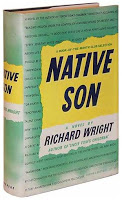This content is being reviewed in light of recent changes to federal guidance.
Native Son
 Today, I round out my “What Wikipedia has taught me about African American Novels” week by ending with Richard Wright’s Native Son. Over the course of the week (link expired), I have picked five novels in the “100 Novels Collection” (link expired) to analyze and better understand how Wikipedia frames African American novels and presents information to larger audiences.
Today, I round out my “What Wikipedia has taught me about African American Novels” week by ending with Richard Wright’s Native Son. Over the course of the week (link expired), I have picked five novels in the “100 Novels Collection” (link expired) to analyze and better understand how Wikipedia frames African American novels and presents information to larger audiences.
As internet users, we should pay more attention to Wikipedia to better understand its influence on black writing. Like it or not, Wikipedia is a source that internet users draw on frequently for information. More attention to the particular trends, graphics, and sources drawn on to categorize black writing will provide us with a better understanding of how the site influences popular culture and African American literature in general.
What Wikipedia Taught Me About Native Son:
-
I learned what James Baldwin said about the novel: “No American Negro exists who does not have his private Bigger Thomas living in his skull.”
- I learned what Franz Fanon wrote about the novel in his 1952 essay L’Experience Vecue du Noir, or “The Fact of Blackness.” He writes, “In the end, Bigger Thomas acts. To put an end to his tension, he acts, he responds to the world’s anticipation.”
- I learned the plot analyses of each section of the novel—Book One: Fear; Book Two: Flight; Book Three: Fate;
- I learned character breakdowns of all of the major characters
- I learned that Wright based aspects of the novel on the 1938 arrest and trial of Robert Nixon, executed in 1939 following a series of “brick bat murders” in Los Angeles and Chicago.
- I learned that Native Son was the original title of Chicago writer Nelson Algren’s first novel Somebody in Boots, based on a piece of doggerel about the first Texan.
- I learned that according to Bettina Drew’s 1989 biography Nelson Algren: A Life on the Wild Side, he bequeathed the title “Native Son” to Wright.
- I learned that Wright’s protest novel was an immediate best-seller, selling 250,000 hardcover copies within three weeks of its publication by the Book-of-the-Month Club on March 1, 1940.
- I learned that the book was criticized by some of Wright’s fellow African-American writers. James Baldwin’s 1948 essay “Everybody’s Protest Novel” dismissed Native Son as protest fiction, and therefore limited in its understanding of human character and its artistic value. The essay was collected with nine others in Baldwin’s Notes of a Native Son (1955).
- I learned that the book is number 71 on the American Library Association’s list of the 100 Most Frequently Challenged Books of 1990-2000.
- I learned that the Modern Library placed it number 20 on its list of the 100 best novels of the 20th Century.
- I learned that Time Magazine also included the novel in its TIME 100 Best English-language Novels from 1923 to 2005.
- I learned Native Son has two movie adaptations.
- I learned Oprah Winfrey played Mrs. Thomas in the 1986 remake of the movie Native Son.